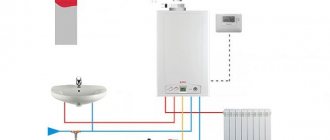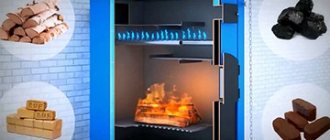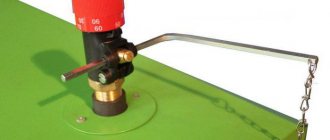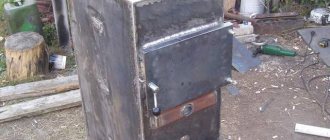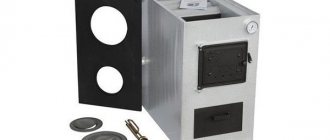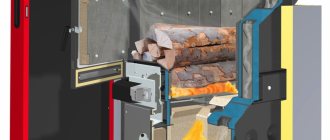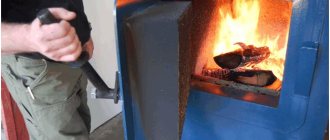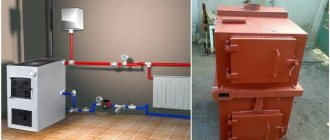Share on social media networks:
Any owner of a private home with an individual heating system must pay close attention to the installed equipment. Otherwise, over time, its efficiency will significantly decrease, and fuel consumption will increase significantly. This especially applies to solid fuel boilers, during the combustion of raw materials in which plaque forms on the walls of the boiler over time. How to clean the boiler from tar and other combustion products? You can stop searching forums and websites for useful advice, because in this article we have collected all the necessary information on this issue and will tell you why resin collects in the boiler and how to get rid of it.
Raw materials for combustion process
In order to start the process of firing a solid fuel boiler, several types of raw materials are used:
- coal of various types;
- firewood from various types of wood, pellets;
- peat;
- briquettes
Important! During the combustion of this raw material, as a rule, ash, ash and other combustion products remain, which settle on the working surface of the combustion chamber, as a result, this has a negative effect on the operation of the boiler.
How to clean a burner with nozzles
The burner is the most important part; it must be perfectly clean, otherwise there will be no fuel savings. This applies to any type of boiler: wall-mounted or floor-mounted.
- the gas supply must be shut off;
- the burner is removed from the boiler;
- unscrew the nozzle (it’s convenient to take a photo before doing this so you know how to put the nozzle back);
- The nozzle is carefully cleaned with a soft brush;
- The burner is cleaned with a brush;
- The burner holes are purged with any pump (regular bicycle or car);
- the nozzle is inserted back into the burner (do not confuse its location);
- The burner and nozzle are put in place.
Causes of combustion products and how to remove them
The by-products that appear during the combustion process are:
The reasons for the appearance of these substances lie in some important points:
- there is not enough oxygen for the combustion process;
- extremely low fuel combustion temperature.
Important! Do not forget that the chimney is an integral part of the heating system of the house, and just like the boiler, it requires periodic cleaning. You will find detailed information on how to carry out this procedure in our article “Cleaning the chimney”.
Factors that influence the appearance of resin:
- the fuel you use is of poor quality;
- the moisture level of the fuel material is very high;
- the temperature at which the boiler operates is quite low;
- you are loading too much fuel into the firebox.
Tar appears in several other cases:
- rather weak injection of air flow into the combustion chamber of the pyrolysis boiler;
- the unit is incorrectly designed;
- The height of your chimney is too low.
As you can see, the main reasons for the appearance of harmful substances are low-quality fuel, as well as the technical aspects of organizing the combustion procedure.
Important! Experts advise: use fuel that is only of high quality. Otherwise, the boiler will rapidly wear out, and you will constantly be thinking about how to clean the boiler from resin so that this procedure has a longer-term effect.
But still, how is tar formed in furnaces?
The main element that makes up wood, brown coal or coal is carbon. Water makes up 20-35% of the weight of wood, and potassium, magnesium, sodium and other elements do not make up more than 1-3% of the weight and remain mainly in ash residues, taking a minimal part in the formation of tar.
It is carbon that burns in furnaces. And if in simple solid fuel boilers fairly simple processes occur that are easy to control but difficult to automate, then in pyrolysis furnaces the above-mentioned process of dry distillation of wood can occur much more often.
Under the influence of high temperature and insufficient oxygen, thermal decomposition of wood occurs: wood gas is released, which consists of carbon monoxide, hydrogen, nitrogen (found in the primary air), as well as the main heroes of the occasion, hydrocarbons, compounds of carbon with nitrogen, oxygen, hydrogen (for example, methane, propane, acetylene). Further, due to the secondary injection of air into the afterburning chamber of the boiler, combustion of the released gases occurs. When these gases, namely hydrocarbons, are incompletely burned, a chemical reaction occurs during which tar is formed.
With incomplete combustion of these gases, namely hydrocarbons (methane, propane, etc.), instead of combustion, a chemical reaction occurs, during which tar is formed.
Pyrolysis boilers are known for their high efficiency, their efficiency; they are capable of using 97-98% of the energy of chemical bonds of wood and carbon. If fuel oil and tar form in the boiler, this means that you should forget about efficiency, and your boiler is configured, assembled or installed incorrectly!
The main reason for the appearance of tar in the chimney is an insufficient amount of oxygen supplied to the combustion chamber, which leads to a decrease in the temperature at which the process should occur.
You can also identify reasons such as improper assembly and layout, low-power boiler supercharger (pump), voltage drop in the network, insufficiently high chimney, damp firewood. You should also not be too economical: supplying air below a certain level can extend the combustion process (pyrolysis) in the boiler over a longer period of time, but will lead to the formation of tar. And this is fraught not only with regular cleaning of the chimney, but also with failure of the boiler and combustion chamber.
How to deal with tar if it has already begun to form?
Raising combustion temperature. This can be done by increasing the air supply and using drier firewood.
Changing the geometry, length of the chimney, gas ducts. This should reduce gas resistance, improve traction, and thus increase air supply without increasing the power of the supercharger (pump).
Increasing the combustion temperature by adjusting the pump performance or adding drier firewood at the final stage of the fire. This will help burn out the tar that has formed in the chimney.
If a significant amount of tar appears in the chimney, it should first be cleaned using a chemical or old-fashioned method. And only then change the system configuration.
A significant increase in temperature and subsequent ignition of tar in the chimney can lead to a roof fire or other catastrophic consequences. Tar is flammable, so you should be extremely careful.
A tar fire will clear the chimney, but can be a fire hazard.
There is also a fairly popular theory that the formation of tar depends on the type of wood. You can find a lot of information on the Internet that tar is formed only from heating with coniferous or certain types of wood, and you can fight it by burning birch firewood. Here it is worth remembering that our ancestors extracted tar from birch bark, placing it in a closed pot with a hole in the bottom and heating it. And the burning of tar in the chimney when changing fuel can be explained not by a different chemical composition, but by a better degree of drying or a higher combustion temperature. So associating tar with tree resin is just a misconception.
What are the negative consequences of the accumulation of combustion products?
Excessive amounts of harmful substances inside a solid fuel boiler lead to some consequences:
- The thermal capabilities of the boiler drop very quickly;
- heating of the house is significantly reduced;
- fuel consumption is rapidly increasing;
- service life is extremely reduced.
Important! Experts' comments: timely cleaning of a solid fuel boiler from carbon deposits contributes to its more efficient functioning.
What should be the regularity of cleaning processes?
The interval between cleaning processes for wood, pyrolysis or pellet boilers depends, first of all, on the quality of the fuel material:
- if you use high-quality fuel, the boiler unit must be cleaned approximately once a month;
- If you use fuel of low quality and with a high level of humidity, cleaning should be done once every 15–20 days.
Important! Despite the above deadlines, you should always monitor the operation of your unit, and if there is a violation of the operating rhythm, you can clean the solid fuel heating boiler from tar outside the schedule.
Content
- Step 1. Make a round hole in the center of the lid.
- Step 2. Cut the sides of the bottles into strips lengthwise, approximately 1.5 or 2 cm wide.
- Step 3: Now insert one bottle into the other and attach a thick wire to one end.
- Step 4. Spread the cut strips of plastic evenly in a circle and secure the steel cable.
Strange as it may sound, the profession of chimney sweep still exists all over the world. And the traditional cylinder for a chimney sweep has always been the privilege of only the master. To become one, you need to serve as an apprentice for more than one year, this specialty is so complex.
Benefits of Regular Cleaning
Cleaning such a boiler with your own hands is quite simple, especially with the help of special tools and substances. There are only a few ways to clean a solid fuel boiler with your own hands.
You can clean the boiler using:
- pokers;
- various special scrapers;
- blades of different parameters;
- metal brushes;
- ruffs;
- specialized means for cleaning boilers, for example, powder for cleaning solid fuel boilers.
Follow the link and learn how to make a “Do-it-yourself chimney brush.”
How to clean the fire tube heat exchanger of a single-circuit boiler
Cleaning floor-standing boilers with a fire tube heat exchanger differs from the same procedure for mounted equipment.
Here, to carry out the procedure, the heat exchanger is not removed, but only access to it is provided. To complete the work you will need the following tools:
- open-end wrenches;
- metal brush;
- hand brush for metal;
- screwdriver;
- natural bristle brush or nylon brush.
The first mandatory action is to turn off the gas supply valve. Next, you need to complete three stages of work - providing access to the heat exchanger, cleaning parts, and assembling the boiler. The disassembly/assembly steps depend on the specific model. How to clean boilers of the MAYAK-12 KS model can be seen in detail in the video.
The process of cleaning a solid fuel boiler from tar, tar and soot:
- First, be sure to warm up your solid fuel boiler, then cool it to an acceptable temperature.
- Using shovels and scrapers, remove substances from the surface of the walls of this device.
- After cleaning is complete, reheat the boiler to completely burn off the residue.
You can clean solid fuel boilers from tar, tar and tar in a way that best suits your financial and labor capabilities. For example, there are many solutions that we will describe to you below.
Chemical cleaning
A special feature of this method of cleaning a solid fuel boiler from all kinds of harmful substances is the use of various chemicals. In this case, the entire amount of work can be completed in two ways:
- Pour the product directly onto the already burning fuel. Such substances contain a whole set of crystals that react with tar and soot, crumble them, and then come out with smoke.
- Using special chemicals, the working surfaces of a solid fuel boiler that are contaminated with tar and resin are treated. As a rule, the main components of all these products are acid-based reagents and solvents.
Important! When cleaning a solid fuel boiler with chemicals, you must follow all safety precautions.
Soft blasting
This method is considered a technology for cleaning a wood-burning or pyrolysis boiler from combustion products. The essence of this method is that, using a special device, a special mixture containing baking soda and chalk is applied to the contaminated surface of the boiler.
Important! The Americans invented this method.
Cleaning the boiler with steam
The essence of the method lies in the fact that with the help of a steam generator the entire surface of the boiler walls is treated, while the boiler unit is still perfectly disinfected.
Traditional methods
There are also several popular methods for cleaning solid fuel boilers from soot and tar. For example:
- Sprinkle ordinary table salt on burning wood, which will help remove soot in tandem with smoke.
- You can also place dried potato peelings on the burning fuel, which will release starch and thereby significantly soften the contaminated surfaces for subsequent cleaning.
Important! Chimney cleaning can also be done using folk remedies. Information on how to find out that a chimney needs cleaning, why it needs to be done and many other practical tips can be found in our review “How to clean a chimney from soot using folk remedies?”
Everyone who lives in a country house or has a summer cottage during the cold season faces a heating problem. Most often, heating systems with a solid fuel boiler as the main unit are used to heat rooms.
In order for such a unit to work properly and “use” raw materials economically, it needs to be cleaned on time and thoroughly from contaminants that arise during operation. Read on to see how this happens.
How to clean soot from fireplace glass?
Cleaning the glass of a fireplace from soot and carbon deposits can be done in several ways.
The first of these is the use of wood ash, a sponge and clean water. To do this, you need to lightly moisten the sponge in water, dip it in the ash and wipe the glass of the fire door several times. After completely removing the carbon deposits, you need to wash the sponge in water and use it to wash the glass, then wipe it dry with toilet paper, a piece of newspaper or paper towel.
Another folk remedy for cleaning fireplace glass is ammonia. To use it you need:
- Mix a teaspoon of ammonia with half a liter of water and a teaspoon of vinegar.
- Pour the resulting solution into a spray bottle.
- Wear rubber gloves.
- Spray the resulting product onto the entire surface of the fireplace glass and leave for several minutes to interact with the contaminated layer of soot and carbon deposits.
- Wipe the glass door with a newspaper or paper towel.
- If there are carbon residues, repeat the entire cleaning process until the dirt is completely removed.
- Finally, rinse the glass with clean water and dry it with a paper towel.
You can also use any chemical fireplace glass cleaner designed to clean all glass surfaces. The best cleaners are:
You can also clean the glass of the fireplace from soot using a special scraper designed to remove soot, carbon deposits and soot. It's quite simple to use. You just need to scrape off all the plaque from the surface of the glass, wash it with a sponge and clean water and wipe it dry with a paper towel.
After completely cleaning the fireplace, you should replace the firewood grate, wash the floor, remove the film from the interior items, and you can continue to use the fireplace device for its intended purpose.
Disassembling and removing soot from the inner surface of the boiler
Please note that contactless cleaning eliminates the problem only for a while. If you have difficulties with mechanical cleaning, use the services of professionals
Expert opinion
Ekaterina Korneva, expert in the field of care, cleanliness and beauty
I will help you understand all the intricacies.
All of them, in the form of a dense, viscous sediment, cover the inner surface of the pipes and create conditions for retaining soot, carbon deposits and soot. After using the fireplace for a long time, the time comes when it becomes more difficult to light it, the firewood begins to constantly die out at the beginning of the kindling, and clouds of smoke tend not to go up the chimney, but strive to penetrate into the room. Brush made from plastic bottles: cheap and cheerful If you have any questions, please contact me, I will be happy to answer!
Types of pollution
The types of waste are formed depending on what exactly is thrown into the boiler for combustion to release heat. The consequences of combustion are the formation of ash and ash, and other products, on the walls of the unit. If you do not clear the surface of them in time, the efficiency of the boiler becomes significantly lower.
The main cause of soot is the lack of oxygen during the combustion process. If you use low-quality fuel, put wet products into the boiler or, in order to save money, set the boiler to constantly operate in low mode, be prepared to deal with soot. An overcrowded firebox also causes malfunctions.
Tar is formed if there is low air flow in the combustion chamber and the unit is not configured correctly. A low chimney also provokes the accumulation of tar.
Consequences of not cleaning
If there are a lot of harmful substances in the boiler and the user does not take any action to eliminate them, the following negative processes occur:
- the boiler begins to heat worse;
- the house becomes noticeably cool, even when setting the usual operating mode indicators;
- there is a need to use more fuel;
- The service life of the boiler is rapidly decreasing.
The benefit of regular cleaning is to extend the life of the unit and ensure its proper operation.
How often should I clean?
To determine the frequency of cleaning, it is important to consider the quality of the fuel material used.
If you don’t save money and prefer to buy proven fuel, then the boiler can be cleaned once a month. If you choose affordable options, you will have to clean them every 15-20 days.
Frequency figures are approximate. The main criterion is the operation of the boiler. Doesn't function as well as before? It is advisable to perform the reading out of turn.
Cleaning methods
As has already become clear, cleaning is a mandatory process. All that remains is to figure out how to carry it out correctly. Four options are practiced.
The importance of timely cleaning of a gas boiler
The soot formed during gas combustion contains caustic toxic substances that corrode the metal and gradually lead to corrosion of the elements. If you do not clean gas units on time, this is fraught with the following consequences:
- decreased traction;
- a decrease in the efficiency of a gas boiler;
- fire;
- the appearance of soot.
The frequency of cleaning a gas boiler is usually indicated in its technical documentation. Various units have excellent cleaning times. Also, different models of units require a certain cleaning frequency. For example, devices with a single circuit require maintenance less often than their double-circuit counterparts.
Note! The number of cleanings is also affected by the quality of gas and water.
Clear signs that your gas boiler needs cleaning are:
- the device cannot reach the desired temperature;
- gas and electricity consumption increased;
- there was a smell of carbon monoxide and soot;
- the flame burns unstable.
To avoid having to call specialists and pay them considerable sums for professional cleaning, it is better to carry out timely maintenance of the gas boiler yourself. The instructions included with the unit will help you figure out how to properly remove the elements that need cleaning.
Causes of combustion products
A solid fuel boiler can operate on various types of fuel: coal, pellets, firewood, peat.
You can find out the price and buy heating equipment and related products from us. Write, call and come to one of the stores in your city. Delivery throughout the Russian Federation and CIS countries.
After the fuel burns, various deposits usually settle on the walls of the combustion chamber, such as ash, ash, soot, resin, tar. All these residues negatively affect the operation of the boiler.
The formation of soot is due to a number of reasons:
- First of all, the fact that too little oxygen enters the system.
- Another reason is the insufficiently high temperature that accompanies the combustion process.
The following factors can cause the appearance of resin deposits on the walls:
- raw fuel is used;
- solid fuel boiler operates at low temperature;
- Too much fuel is loaded into one stowage.
Choose only high-quality fuel for a solid fuel boiler. Otherwise, your unit will often break down and its service life will be significantly reduced.
Safety precautions
- Using a synthetic or lint brush, clean the pipe walls from the top layer of soot; to clean narrow passages, you should use a brush, but cleaning the fireplace chimney does not end there.
- In addition to soot, resins can accumulate on the chimney pipe in the form of hard lamellar deposits. You can remove them using a metal spatula.
- After the resins have been removed, you need to take a special chimney brush, which should be several centimeters in diameter larger than the pipe, and use it to remove the remaining soot, making vertical movements up and down inside the pipe.
Clogging of chimney ducts is a natural process that occurs as a result of combustion. Only part of the fuel, breaking down into fractions, acquires a gaseous form and is released into the atmosphere as an emission.
Folk remedies Recipes for masks At home Hair loss in women How to stimulate growth Causes of hair loss Hair loss in men Review of vitamins Helpful tips
Negative effects of deposits and cleaning frequency
If you do not regularly clean the boiler, negative consequences cannot be avoided. First of all, heat transfer rates decrease. The room will warm up slowly and the heat will spread unevenly. The next disadvantage is that you will need to use more fuel, and costs will increase accordingly.
A solid fuel boiler that is not promptly cleaned of ash, soot and tar will not last very long, since its main elements responsible for high-quality heating will quickly fail.
By regularly cleaning the pyrolysis boiler, you will ensure not only its efficient operation, but also increase its service life.
The frequency of cleaning procedures for a solid fuel boiler depends on the quality of the fuel used.
If you use high-quality firewood, coal, etc., then it will be enough to clean the unit once every 30-40 days. If you use low quality fuel with high humidity, then the boiler must be cleaned at least once every two weeks.
In any case, you need to constantly monitor the operation of the solid fuel boiler. If you notice any problems or malfunctions, then carry out extraordinary cleaning, regardless of when it was last done.
Areas of application
Depending on the thickness of the polycarbonate sheet, many designs can be made. Corrugated sheets with a wavy or trapezoidal structure are considered a good alternative to roofing coverings or an addition to them. It is also used for the construction of canopies, canopies, terraces and verandas. Honeycomb sheets are most often found in greenhouses and conservatories - this is where their properties are most in demand.
And also the use of polycarbonate sheets is relevant for the following areas:
- construction of a shower for a summer residence;
- creating a cover for the pool;
- fencing of sports grounds and public areas;
- glazing of greenhouses, winter gardens, balconies;
- production of swings, benches, gazebos, and other garden structures;
- formation of internal partitions in offices, banks and other institutions;
- production of advertising and information structures;
- road construction - as noise-absorbing shields, stopping pavilions.
Products made from sheet polycarbonate, thanks to simple and convenient cutting of the material, can have a decorative appearance. With its help, stylish transparent grilles are made for windows, curly hedges and gazebo frames. Smooth sheets are widely used in upgrading cars, bicycles, and motorcycles; they can be given different shapes.
Cleaning methods
There are three ways to clean a solid fuel boiler from soot, tar and tar: mechanical, steam and chemical.
Each of the methods has its own distinctive features. Let's look at each of them.
Mechanical
The process of mechanical boiler cleaning is based on removing combustion products from the walls of the unit using special tools. For this purpose, the following are used: pokers, various-sized scrapers, spatulas, metal brushes, and brushes.
Do not forget that you need to start the process of cleaning the boiler from soot only after the device has completely cooled down.
It is important that during the process of cleaning the boiler from soot, the damper is not closed.
Removal of resin and tar from the walls of the unit is carried out as follows:
- Initially, the heater needs to be warmed up. Resin and tar are quite hard, and when the boilers heat up, they soften and become easier to get rid of.
- Next, using shovels and scrapers, you need to get rid of these deposits.
- After the cleaning process is completed, you need to increase the temperature of the boiler. This is done so that the remaining resin and tar burn out.
Chemical
This method of cleaning a solid fuel boiler is very popular. It is based on the use of different chemical compositions.
To clean the unit with a chemical, you need to heat the reagent and use a special pump to fill the boiler system with it.
The most commonly used acids are sulfamic, adipic, and helium.
Adipic acid is diluted with water and carefully poured into the boiler using a pump. Once in the device, the mixture reacts with deposits, transforms into acidic salts and dissolves. At the next stage, you need to release the pressure and wait until the salts precipitate, and then wash them off with water.
Sulfamic acid is also diluted with water, only in a separate container. Then it needs to be pumped into the cooled boiler under pressure. Next, you need to wait a while for the acid to react with the plaque and rinse the unit.
Gel is not an acid. But it is also effectively capable of cleaning the boiler from deposits without damaging its walls.
In order to clean soot from a chimney, rock salt is most often used. It is added to the firebox the moment the fuel burns. However, this method is used only for preventive purposes. It will not be possible to completely get rid of soot with its help.
Potato peeling is more effective in combating soot. The method is as follows: while the fuel is burning, they need to be poured into the combustion chamber. Starch will begin to release along with the steam. It is due to this that the soot will soften and be removed from the chimney. After completing this procedure, the boiler must be thoroughly cleaned.
When cleaning a solid fuel boiler with chemicals, strictly follow safety precautions.
Steam
This method involves treating the walls of a solid fuel boiler using a steam generator. This way you will not only get rid of dirt, but also fungus and mold in your heating device.
Thus, you can clean the boiler from tar, soot and tar using any of the proposed methods. Some will take longer and require a lot of effort from you. Others will allow you to quickly get rid of deposits, but will be more expensive. In any case, the choice of method is yours. The main thing is not to forget to regularly clean the solid fuel boiler, because the efficiency of its operation will depend on this.
Principle of operation
To figure out how to properly heat a boiler with coal, let’s understand the principle of operation of such devices. When coal burns, heat is released, which heats the heat exchanger with liquid. It is already, under the action of a pump system, supplied to the radiators, heating the air in the necessary rooms.
The equipment is quite simple. At the bottom there is an ash pit where slag and ash are collected. Above it are the grate bars, on which the fuel directly burns. The heat exchanger can be located either around the firebox or on top.
There are also air-heated coal boilers. They directly heat the air in the room. Their design is much simpler, since there is no intermediary in the form of a liquid coolant. They are used more for heating garages and industrial premises.
Long-burning models and pyrolysis devices have an increased level of efficiency. In the first, air is supplied from above, due to which only the top layer of fuel constantly burns. This allows you to load a lot of coal at one time, which will smolder slowly.
Sectional view of a coal pyrolysis boiler
In pyrolysis equipment, increased efficiency is achieved by additional combustion of volatile gases that are released during the oxidation of coal. For this purpose, they are equipped with specially shaped combustion chambers. In order for gas release to occur more actively, a particularly high level of temperature is maintained inside the furnace.
